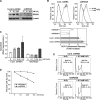Novel oxidative stress-responsive gene ERS25 functions as a regulator of the heat-shock and cell death response
- PMID: 18326488
- PMCID: PMC2442354
- DOI: 10.1074/jbc.M709656200
Novel oxidative stress-responsive gene ERS25 functions as a regulator of the heat-shock and cell death response
Abstract
Members of the yeast p24 family, including Emp24p and Erv25p, exist as heteromeric complexes that have been proposed to cycle between the endoplasmic reticulum (ER) and Golgi compartments. The specific functions and sites of action of p24 proteins are still unknown. Here we identified a human homolog of the yeast p24 family of proteins, named ERS25 (endoplasmic reticulum stress-response protein 25), and investigated its role in stress response. ERS25 is predicted to have an ER localization signal peptide, a GOLD (Golgi dynamics) domain, which is found in several eukaryotic Golgi and lipid-trafficking proteins, a coiled-coil region, and a transmembrane domain. We demonstrate that ERS25 is localized to the ER and is induced by ER-specific stress, heat shock, and oxidative stress. The selective induction of ERS25 by brefeldin A, but not tunicamycin, implicates the involvement of ERS25 in protein trafficking between the ER and the Golgi. Small interfering RNA-mediated inhibition of ERS25 results in a significant decrease in apoptosis as well as a reduction of reactive oxygen species induced by oxidative stress. Moreover, ERS25 depletion results in a significant increase in the levels of the ER chaperone HSP70 in response to heat-shock stress through increased levels of HSF-1. We also found that inhibition of ERS25 induction in response to heat shock enhanced the binding of HSP70 to Apaf-1, which is likely to interfere in stress-mediated apoptosis. Together, the data presented here demonstrate that ERS25 may play a critical role in regulation of heat-shock response and apoptosis.
Figures






Similar articles
-
Distinct roles for the cytoplasmic tail sequences of Emp24p and Erv25p in transport between the endoplasmic reticulum and Golgi complex.J Biol Chem. 2001 Nov 16;276(46):43040-8. doi: 10.1074/jbc.M108113200. Epub 2001 Sep 17. J Biol Chem. 2001. PMID: 11560939
-
Erv25p, a component of COPII-coated vesicles, forms a complex with Emp24p that is required for efficient endoplasmic reticulum to Golgi transport.J Biol Chem. 1996 Oct 25;271(43):26939-46. doi: 10.1074/jbc.271.43.26939. J Biol Chem. 1996. PMID: 8900179
-
Endoplasmic reticulum chaperones GRP78 and calreticulin prevent oxidative stress, Ca2+ disturbances, and cell death in renal epithelial cells.J Biol Chem. 1997 Aug 29;272(35):21751-9. doi: 10.1074/jbc.272.35.21751. J Biol Chem. 1997. PMID: 9268304
-
The glucose-regulated proteins: stress induction and clinical applications.Trends Biochem Sci. 2001 Aug;26(8):504-10. doi: 10.1016/s0968-0004(01)01908-9. Trends Biochem Sci. 2001. PMID: 11504627 Review.
-
Glucose-regulated stress proteins and antibacterial immunity.Trends Microbiol. 2003 Nov;11(11):519-26. doi: 10.1016/j.tim.2003.09.001. Trends Microbiol. 2003. PMID: 14607069 Review.
Cited by
-
Down-regulation of GRP78 alleviates lipopolysaccharide-induced acute kidney injury.Int Urol Nephrol. 2018 Nov;50(11):2099-2107. doi: 10.1007/s11255-018-1911-0. Epub 2018 Jun 18. Int Urol Nephrol. 2018. PMID: 29915879
-
Identification of Genetic Differentiation between Waxy and Common Maize by SNP Genotyping.PLoS One. 2015 Nov 13;10(11):e0142585. doi: 10.1371/journal.pone.0142585. eCollection 2015. PLoS One. 2015. PMID: 26566240 Free PMC article.
-
The trafficking protein Tmed2/p24beta(1) is required for morphogenesis of the mouse embryo and placenta.Dev Biol. 2010 May 1;341(1):154-66. doi: 10.1016/j.ydbio.2010.02.019. Epub 2010 Feb 21. Dev Biol. 2010. PMID: 20178780 Free PMC article.
-
Characterization and comparison of the leukocyte transcriptomes of three cattle breeds.PLoS One. 2012;7(1):e30244. doi: 10.1371/journal.pone.0030244. Epub 2012 Jan 23. PLoS One. 2012. PMID: 22291923 Free PMC article.
-
Compartmentalized Proteomic Profiling Outlines the Crucial Role of the Classical Secretory Pathway during Recombinant Protein Production in Chinese Hamster Ovary Cells.ACS Omega. 2021 May 3;6(19):12439-12458. doi: 10.1021/acsomega.0c06030. eCollection 2021 May 18. ACS Omega. 2021. PMID: 34056395 Free PMC article.
References
-
- Bannykh, S. I., Nishimura, N., and Balch, W. E. (1998) Trends Cell Biol. 8 21–25 - PubMed
-
- Blum, R., Pfeiffer, F., Feick, P., Nastainczyk, W., Kohler, B., Schafer, K. H., and Schulz, I. (1999) J. Cell Sci. 112 537–548 - PubMed
-
- Gommel, D., Orci, L., Emig, E. M., Hannah, M. J., Ravazzola, M., Nickel, W., Helms, J. B., Wieland, F. T., and Sohn, K. (1999) FEBS Lett. 447 179–185 - PubMed
Publication types
MeSH terms
Substances
Grants and funding
LinkOut - more resources
Full Text Sources
Molecular Biology Databases

